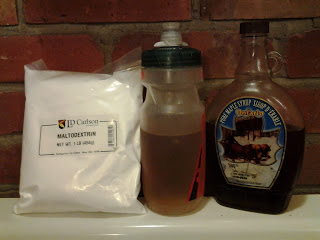Every morning strange creatures converge on trailheads, tracks, and sports stores. Droves of fluorescent, polyester-clad hominids laden with belts, bottles, bars, handhelds and hydration packs. You could be forgiven for mistaking these gatherings for trans-Saharan expedition parties. In fact, it’s just the local hobby joggers out for their bi-weekly jaunt around the block.
Triathletes are no better when it comes to gratuitous fueling and hydration. Some may be surprised to learn that most non-sedentary individuals can survive short bouts of exercise without a sugary IV drip, despite what sports store clerks preach. In fact, well-trained athletes have a couple hours worth of readily-accessible fuel (glycogen) stored in their muscles and liver. There’s even evidence that training in a fasted or glycogen-depleted state can produce beneficial adaptations (for some athletes doing certain workouts during specific training phases).
But let’s assume that some of your training sessions are demanding enough to require fueling and hydration. What’s a health-conscious athlete to do? Many athletes pay meticulous attention to their diet, only to give themselves a free pass when it comes to workouts. Obviously your nutritional needs are different mid-workout than mid-movie marathon, but don’t kid yourself; that Triple Chocolate “Performance Energy Bar” and Berry Blast “Hydration Formula” are essentially Snickers and Tang with a price markup.
Most sport nutrition products are overprocessed, overpriced and overpackaged. They have interminable and unpronounceable ingredient lists full of creepy additives, flavours and colours. A growing number of athletes are rejecting sports nutrition products in favour of simple, real food whenever possible. For some background, check out this interview with nutrition guru Allen Lim.
Continuing with the Endurance Eats series of wholesome, practical and affordable training food, I’m going to share my favourite homemade energy bar recipe and a few other ideas.
 |
| Confession: This high quality photo should make it evident that these aren’t my bars. I was forced to pirate this photo because my bars all got eaten before I could snap a shot (a good sign). |
You can dial in the sweetness and the carbohydrate, protein and fat ratios to suit your needs and tastes. With a higher protein and fat content, this formula is better suited to longer, lower intensity workouts or pre/post-workout snacking.
1. Melt together in a medium saucepan:
- ¾ natural peanut butter
- ¼ to ¾ brown sugar (to taste, ¾ c. is super sweet)
- ¾ honey, corn syrup or agave nectar
- ½ cocoa powder
- 1 c. chopped nuts and/or seeds (almonds, peanuts, pecans, sunflower, etc.)
- 1 c. dried fruit (raisins, dates, apricots, etc.)
- 1½ c. oats (quick cooking or large flake)
- 1½ c. puffed rice cereal (e.g. Rice Krispies)
3. Thoroughly mix together (kneading with your hands works best) and press into a greased pan. Refrigerator until solidified and cut into bars. Bars freeze well.
 |
| The helping hands of my Dad. He gets credit for this recipe. |
For more bar ideas, check out the Ultimate Energy Bar Formula. Muffins also make a great pocket-sized snack. Here’s my go-to muffin recipe: Medalist medley muffins. And for the hardcore, a sweet potato microwaved or boiled with the skin on provides a simple, if not Spartan, carb fix.
Instead of store-bought sports drinks, try making your own.
Check out my in-depth post about homebrew sports drinks. You can make an effective, customized, gut-friendly sports drink for cents per serving.
 |
| Bananas and PB: my desert island foods. |
Check out other recipes in the Endurance Eats series.










